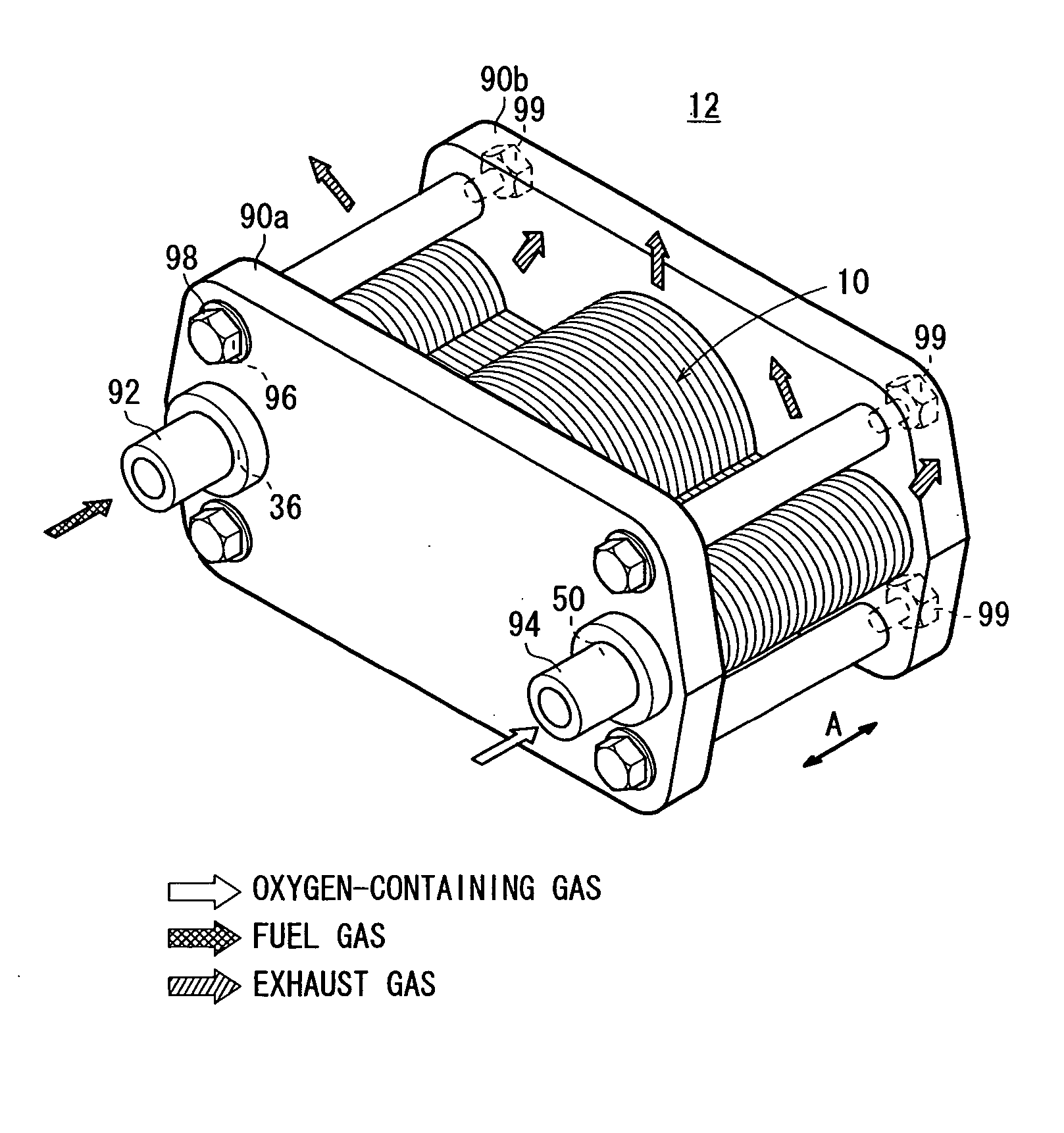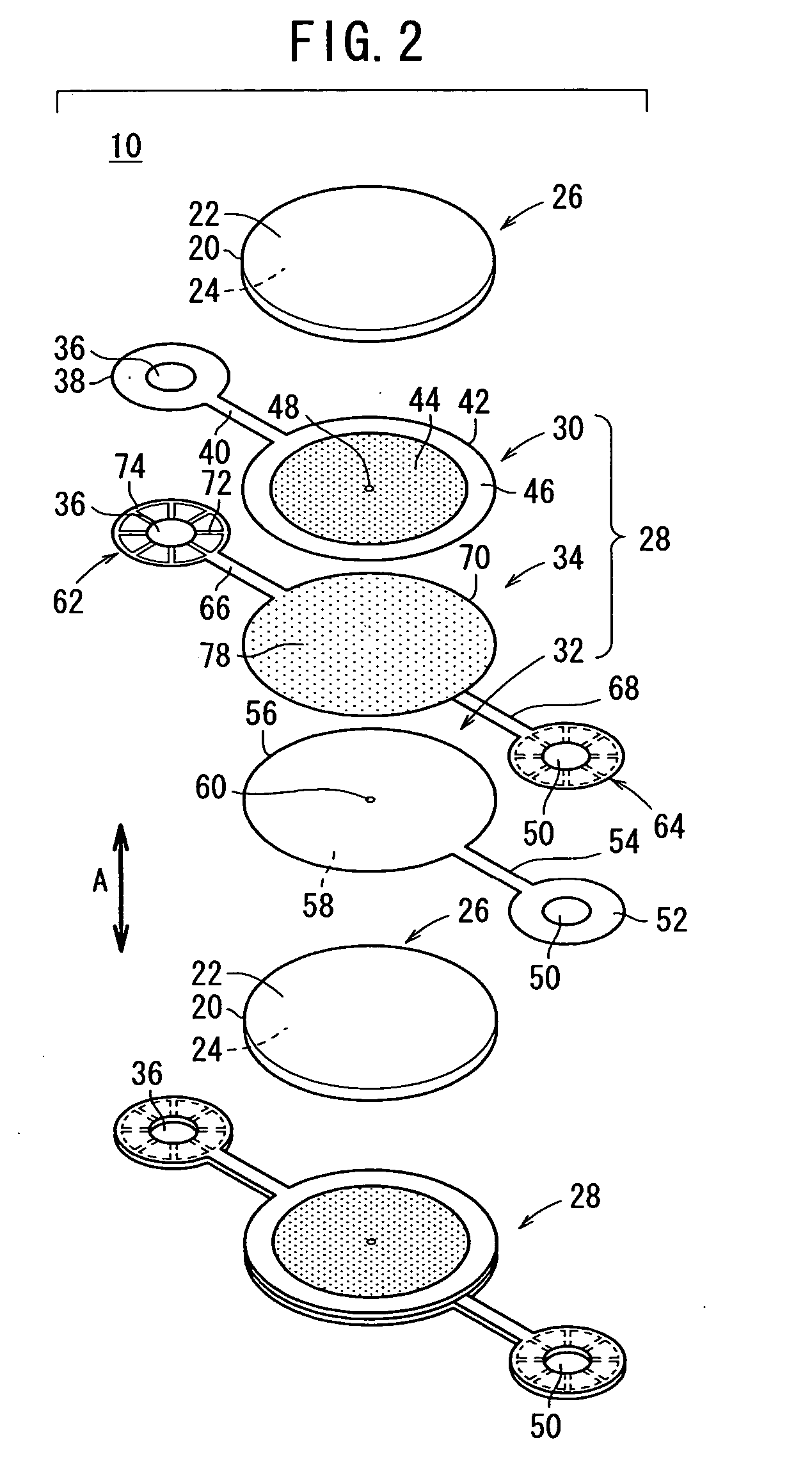Fuel cell and fuel cell stack
a fuel cell and stack technology, applied in the field of fuel cells, can solve the problems of inability to achieve the desired stress absorption function, uneven surface pressure in the current collector, and damage to the electrolyte electrode assembly, etc., and achieve the effect of simple and compact structur
- Summary
- Abstract
- Description
- Claims
- Application Information
AI Technical Summary
Benefits of technology
Problems solved by technology
Method used
Image
Examples
first embodiment
[0047]FIG. 1 is a perspective view schematically showing a fuel cell stack 12 formed by stacking a plurality of fuel cells 10 according to the present invention in a direction indicated by an arrow A.
[0048] The fuel cell 10 is a solid oxide fuel cell (SOFC) used in various applications, including stationary and mobile applications. The fuel cell 10 is mounted on a vehicle. As shown in FIGS. 2 and 3, the fuel cell 10 includes an electrolyte electrode assembly 26. The electrolyte electrode assembly 26 includes a cathode 22, an anode 24, and an electrolyte (electrolyte plate) 20 interposed between the cathode 22 and the anode 24. For example, the electrolyte 20 is made of ion-conductive solid oxide such as stabilized zirconia. The electrolyte electrode assembly 26 has a circular disk shape.
[0049] The fuel cell 10 is formed by sandwiching the electrolyte electrode assembly 26 between a pair of separators 28. The separator 28 includes first and second plates 30, 32, and a third plate 34...
second embodiment
[0080]FIG. 10 is a perspective view schematically showing a fuel cell stack 102 formed by stacking a plurality of fuel cells 100 according to the present invention in a direction indicated by an arrow A. FIG. 11 is a cross sectional view showing part of a fuel cell system 106 in which the fuel cell stack 102 is disposed in a casing 104.
[0081] The constituent elements that are identical to those of the fuel cell 10 according to the first embodiment are labeled with the same reference numeral, and description thereof will be omitted. In a third embodiment as described later, the constituent elements that are identical to those of the fuel cell 10 according to the first embodiment are labeled with the same reference numeral, and description thereof will be omitted.
[0082] As shown in FIGS. 12 and 13, a plurality of, e.g., eight electrolyte electrode assemblies 26 are interposed between a pair of separators 108 to form the fuel cell 100. The electrolyte electrode assemblies 26 are conce...
third embodiment
[0118]FIG. 18 is a perspective view schematically showing a fuel cell stack 202 formed by stacking a plurality of fuel cells 200 according to the present invention in a direction indicated by an arrow A. FIG. 19 is an exploded perspective view showing the fuel cell 200.
[0119] The fuel dell 200 includes a plurality of, e.g., fifteen electrolyte electrode assemblies 26 between a pair of separators 208. Each of the separators 208 includes first and second plates 210, 212 which are stacked together, and a third plate 214 interposed between the first and second plates 210, 212. The first through third plates 210, 212, and 214 are metal plates of, e.g., stainless alloy.
[0120] The first plate 210 has a first small diameter end portion 215. The fuel gas supply passage 36 extends through the first small diameter end portion 215. The first small diameter end portion 215 is integral with first circular disks 218 through a narrow bridge 216. The first circular disks 218 are arranged in directi...
PUM
| Property | Measurement | Unit |
|---|---|---|
| pressure | aaaaa | aaaaa |
| electric energy | aaaaa | aaaaa |
| ion-conductive | aaaaa | aaaaa |
Abstract
Description
Claims
Application Information
 Login to View More
Login to View More - R&D
- Intellectual Property
- Life Sciences
- Materials
- Tech Scout
- Unparalleled Data Quality
- Higher Quality Content
- 60% Fewer Hallucinations
Browse by: Latest US Patents, China's latest patents, Technical Efficacy Thesaurus, Application Domain, Technology Topic, Popular Technical Reports.
© 2025 PatSnap. All rights reserved.Legal|Privacy policy|Modern Slavery Act Transparency Statement|Sitemap|About US| Contact US: help@patsnap.com



